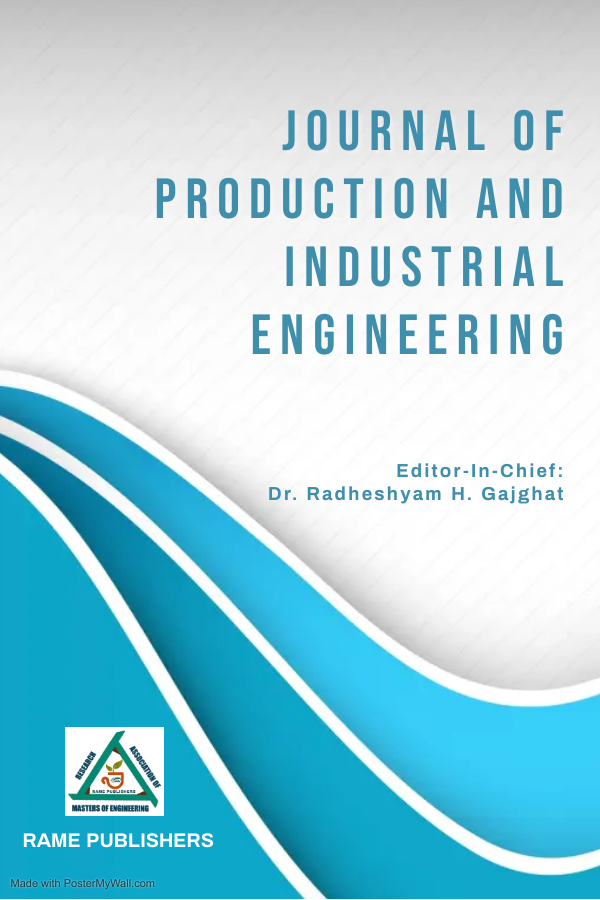Design and Development of Air Pollution Control Device to Remove NOx
Sanju Manna, Raj Kumar Sen, Vikas Sharma, Shubham Sao, Dr. P. S. Rao
Journal of Production and Industrial Engineering
Volume 2: Issue 2, December 2021, pp 43-60
Author's Information
Dr. P. S. Rao1
Corresponding Author
1Department of Mechanical Engineering, Christian College of Engineering & Technology, Bhilai, India
srinivas.indore@gmail.com
Sanju Manna, Raj Kumar Sen, Vikas Sharma, Shubham Sao
2Department of Mechanical Engineering, Christian College of Engineering & Technology, Bhilai, India
Abstract:
Air pollution causes a variety of respiratory ailments, including “asthma, lung cancer, chest pain, congestion, throat inflammation, cardiovascular disorders, and respiratory diseases”. This contaminated environment not only harms human health, but it also harms plant development, reduces soil fertility, and alters soil structure. The primary contributors to this pollution are dust particles of various sizes, NOx gases that may contain microscopic particulates or liquid droplets small enough to enter the lungs and cause serious health concerns. Large particles have the potential to irritate the nose, throat, and eyes. Pneumoconiosis refers to a category of lung disorders caused by breathing in insoluble dusts, primarily mineral dusts, that the lungs cannot eliminate. With any dust particles that escaped the defenses in the nose and airways, the air reaches the tiny air suckers (alveoli) in the inner region of the lungs. So, in order to eliminate this effect, a little effort has been made to reduce the harmful effects of pollution and enhance human life by humanizing the state of the environment. The originality of the concept is that a single device will regulate the complete effect of pollution by separating dust as well as NOx emissions, which are extremely damaging to humans. This device will collect dust and other polluting gases from the environment and separate them. Finally, it will lessen the damaging effect of NOx gases by chemical reaction, leaving clear, clean gases in the air. An air pollution control device can be deployed anywhere to maintain pollution standards and improve human life.Index Terms:
Respiratory problems, Human health, Growth of plants, Soil fertility, Dust particles, Chemical reaction.REFERENCES
- C. A. Miller, R. Hall, R. Stern, “NOx Control Technology Requirements Under the United States 1990 Clean Air Act Amendments Compare to Those in Selected Pacific Rim Countries”, EPA 600/A-94-25.
Online - Nitrogen Oxides: Impacts on Public Health and the Environment, EPA 452/R-97-002.
Online - K. Chithambaramasari, N.V. Mahalakshmi, K. Jayachandran, “Application of SCR technique in NOx reduction of Diesel Engine Emission by Urea Injection Method”, Canadian Journal on mechanical sciences & Engineering, Vol.2 No.8, December 2011.
- S. Ghosh, Dr. S.N. Chaudhuri, D. Dutta, “Reduction of NOx emission by urea injection and marine ferromanganese nodule as SCR of diesel engine”, International Journal of Engineering Research & Technology, Vol.2 issue 1, January 2013.
Online - Ioannis Gekas, Par Gabrielsson, Keld Johansen, “Urea-SCR catalyst system selection for fuel and PM optimized engines and a demonstration of a novel urea injection system”, Society of Automotive Engineers, (2002-01-0289).
Crossref - M. Koebel, M. Elsener and M. Kleemann, "Urea-SCR: a promising technique to reduce NOx emissions from automotive diesel engines", Elsevier catalysis today, Pg. 335-345, 2000.
Crossref - Yamamoto SS, Phalkey R, Malik AA., “A systematic review of air pollution as a risk factor for cardiovascular disease in South Asia: Limited evidence from India and Pakistan”, Int J Hyg Environ Health. 2014; 217:133–44.
Crossref - Zhang W, Qian CN, Zeng YX,. “Air pollution: A smoking gun for cancer”, Chin J Cancer. 2014; 33:173–5.
Crossref - G. Oberdorster, R. Gelein, C. Johnston, P. Mercer, N. Corson, J. Finkelstein, “Relationships Between Respiratory Disease and Exposure to Air Pollution”, International Life Sciences Institute, Washington DC, pp 216-229, 1998.
- Chen B, Kan H. “Air pollution and population health: A global challenge”. Environ Health Prev Med. 2008; 13:94–101.
Crossref - Rumana HS, Sharma RC, Beniwal V, Sharma AK., “A retrospective approach to assess human health risks associated with growing air pollution in urbanized area of Thar Desert, Western Rajasthan, India”, J Environ Health Sci Eng. 2014; 12:23.
Crossref - M. Leenus Jesu Martin and V. Praveena, “A Review on Various After Treatment Techniques to Reduce NOx emissions in a CI Engine,” Journal of the Energy Institute, vol.91, October 2018, pp.704-720.
Crossref
To view full paper, Download here
To View Full Paper
For authors
Author's guidelines Publication Ethics Publication Policies Artical Processing Charges Call for paper Frequently Asked Questions(FAQS) View All Volumes and IssuesPublishing with




